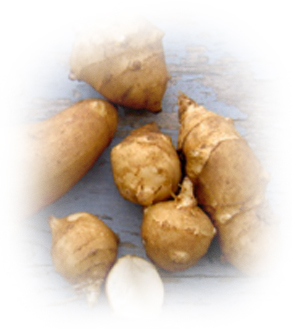Jerusalem artichoke –Sun chokes- Topinambour (French) Girasole (Italian)
|
|
Helianthus tuberousAsteraceae
A close relative to the sunflower “Helios/Helia” in Greek mythology refers to the Sun God, a heliotropic flower that follows the sun’s path from East to West. Tuberous is a modified root/stem similar to potatoes. In the early seventeenth century Samuel de Champlain with the intermediary of a North American Aboriginal tribe discovered the vegetable. Enamored Champlain brought back to England and France both the sun chokes and the part of the tribe. Per chance there was a Brazilian Aboriginal tribe that was also introduced at the French court. They were called “Tupinambu or Tupinambas” and the miss association perpetuated with the French name. Girasol in Italian refers to sunflowers, so a miss heard word derived into “Jerusalem.” This permanent plant delivers a double treat –a chocolate scented yellow flower and a nutty earthy tasting edible. Each plant can produce up to 20 tubers, best harvested after a frost, can be eaten raw, cooked like potatoes, or dried and then grounded into flour. |
|
|
In the Garden
This plant is not for the faint of heart, growing up to 3 meters preferring full sun and forming colonies. Pubescent stems with edible tubers 7.5 to 12.5 cm in size resembling ginger. Leaves opposite or in whorls of 3 on the lower part of the stem, broader at the base and tapered at the tip, yellow flowers with a central disc and 20 petals, and has several flowers per plant. Best time to harvest is after several frosts, cut back stems and carefully dig up tubers, can be stored unwashed in the refrigerator like carrots up to several weeks. Flavor improves as the season progresses. Tubers should be firm and not shriveled up; colours vary from cream to red depending on the cultivar. |
|



